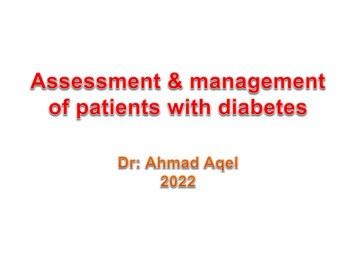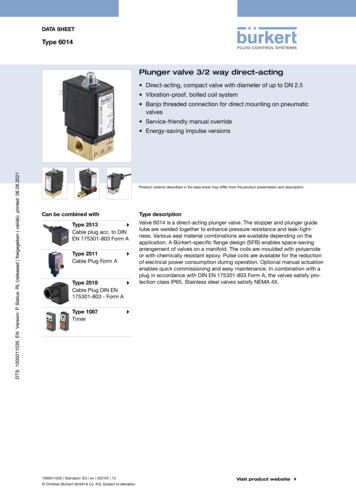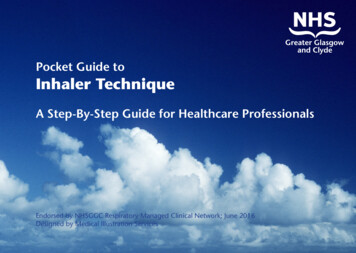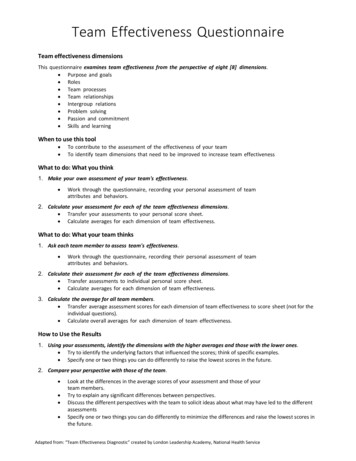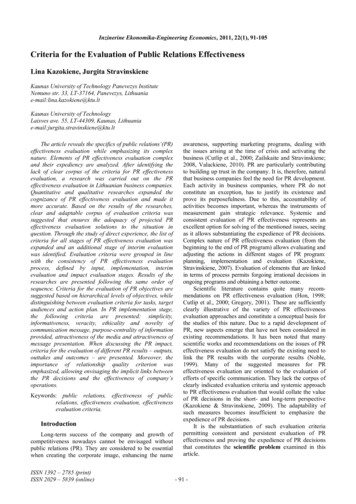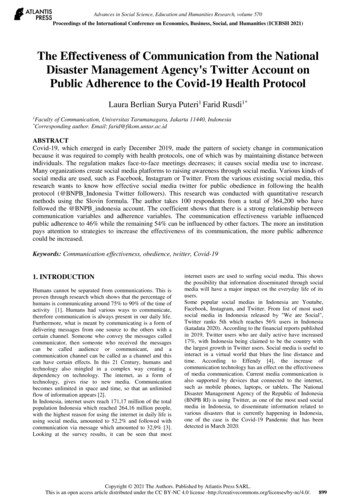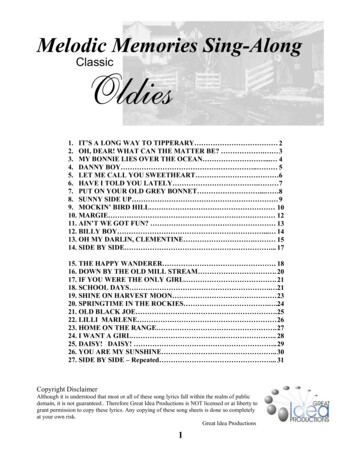
Transcription
Cardiol Ther (2019) ORIGINAL RESEARCHEffectiveness of Long-acting Trimetazidinein Different Clinical Situations in Patientswith Stable Angina Pectoris: Findings from ODA TrialMaria G. Glezer . Vladimir A. Vygodin . on behalf of ODA investigatorsReceived: January 3, 2019 / Published online: February 18, 2019Ó The Author(s) 2019ABSTRACTIntroduction: Trimetazidine (TMZ) has beenshown to be efficacious for angina treatment.The TMZ 80-mg formulation allows one-daily(od) dosage, which could improve symptomcontrol and adherence.Methods: The 3-month, observational, multicenter, prospective ODA (antianginal effectiveness and tolerability of trimetazidine modifiedrelease 80 mg Once Daily in stable Anginapatients in real-world practice) study assessedTMZ 80 mg od effectiveness in stable anginapatients with persistent symptoms despiteThe full list of ODA study investigators is available in thesupplementary material.Enhanced digital features To view enhanced digitalfeatures for this article go to onic supplementary material The onlineversion of this article (https://doi.org/10.1007/s40119019-0128-3) contains supplementary material, which isavailable to authorized users.M. G. Glezer (&)Department of Preventive and EmergencyCardiology, Sechenov First Moscow State MedicalUniversity, Moscow, Russiae-mail: 287ast@mail.ruV. A. VygodinLaboratory of Biostatistics, National MedicalResearch Center for Preventive Medicine of theMinistry of Healthcare, Moscow, Russiatherapy. Two clinical situations were compared:patients who initiated treatment with TMZ80 mg od (initiation group) and patients whowere previously treated with TMZ 20 mg thricedaily (tid) or TMZ 35 mg MR twice daily (bid)and switched to TMZ 80 mg od (switch group).Number of angina attacks, short-acting nitrate(SAN) consumption, self-reported patient dailyactivity, Canadian Cardiovascular Society (CCS)class, adherence to antianginal therapy, overallefficacy and tolerability were assessed.Results: A significant decrease in weekly number of angina attacks was observed for both theinitiation group (n 1841 patients) from4.8 3.5 at baseline to 0.9 1.4 at 3 months(M3) (P \ 0.001), and the switch group(n 1216 patients) from 4.4 1.3 at baseline to0.9 1.3 at M3 (P \ 0.001). Significant reduction in SAN consumption and improvement inCCS class were observed for both groups.Adherence to antianginal therapy improved inboth groups at 1 month (M1) and M3. Overalleffectiveness of TMZ 80 mg od was rated byphysicians as ‘‘very good’’ (68% initiationgroup, 70% switch group), ‘‘good’’ (31% initiation group, 29% switch group), ‘‘moderate’’ (1%,both groups) or ‘‘poor’’ (\ 1%, both groups).Overall tolerability of TMZ 80 mg od was ratedby physicians as ‘‘very good’’ (75%), ‘‘good’’(25%) or ‘‘moderate’’ (\ 1%) in both groups.Conclusions: TMZ 80 mg od, in associationwith other antianginal therapy, effectivelyreduced angina attacks and SAN consumption
Cardiol Ther (2019) 8:69–7870and improved physical activity and adherenceto antianginal therapy both in patients initiating TMZ treatment and those switching from abid or tid formulation.Trial Registration: ISRCTN registry Identifier,ISRCTN97780949.Funding: Servier.Plain Language Summary: Plain languagesummary available for this article.Keywords: Cardiology; Observational study;Real-world evidence; Stable angina; TrimetazidinePLAIN LANGUAGE SUMMARYAngina is a condition that affects more than 100million patients worldwide. The drug trimetazidine has been shown to be efficacious forangina treatment. In the present study, twogroups of patients were analyzed. One groupstarted treatment with a formulation of trimetazidine that allows patients to take only onepill per day. The other group was previouslytreated with other trimetazidine formulationsthat had to be taken two or three times a day,and then switched to the once-daily treatment.In both cases, treatment with the new formulation decreased the number of angina attacksand the use of nitroglycerine. It also improvedphysical activity as reported by patients. Moreover, the number of patients taking theirantianginal medicine as prescribed wasincreased. This new formulation could providean opportunity to improve angina symptomsand increase the number of patientsfollowingtheir treatment.INTRODUCTIONAngina pectoris is a common manifestation ofcoronary artery disease and can have a considerable impact on a patient’s quality of life [1],but despite currently available therapies, it isnot always satisfactorily managed [2–4].Trimetazidine (TMZ) differs from otherantianginal agents in that it acts directly at themyocardial cell level [5]. Add-on TMZ thusrepresents an opportunity to optimizeantianginal treatment. Its efficacy in stable angina treatment, as monotherapy and in combination, has been reported in a meta-analysis ofrandomized clinical trials [6].TMZ is now available as a new formulation of80 mg allowing once-daily (od) intake. TheODA (Anti-anginal effectiveness and tolerabilityof trimetazidine modified release 80 mg OnceDaily in stable Angina patients in real-worldpractice) study [7] assessed in a real-life settingthe effectiveness and tolerability of TMZ 80 mgod, as well as patient adherence to antianginaltreatment, in chronic stable angina patientswith persistent symptoms despite therapy.Herein, we report an additional analysis of theODA study, in patients initiating treatmentwith TMZ 80 mg od and in patients switching toTMZ 80 mg od from previous treatment withTMZ 20 mg tid (thrice daily) or TMZ 35 mg MRbid (twice daily).METHODSODA was a 3-month observational, multicenter,prospective study in 3066 stable angina patientswith persistent symptoms despite therapy,conducted in Russia from March 2017 to June2017 in a real-world clinical setting. The methods and main findings of this study have beenpreviously reported [7].Patients were treated in line with currentrecommendations for coronary artery diseasemanagement. Inclusion of patients into thestudy was exclusively determined by the decision of the physician regarding medical meaningfulness and indication for treatment withTMZ od 80 mg. Non-inclusion criteria weredetailed previously [7].For the analyses presented herein, patientsfor whom information on previous treatmentwith TMZ was available (n 3057) were dividedinto two groups: (i) one group of patients whohad not been previously treated with TMZ andinitiated treatment with TMZ 80 mg od (initiation group) and (ii) one group of patients whowere previously receiving treatment with eitherTMZ 20 mg tid or TMZ 35 mg MR bid and thenswitched to treatment with TMZ 80 mg od(switch group). Of the 3066 patients of the ODA
Cardiol Ther (2019) 8:69–78study population, nine patients were excludedfrom this analysis, because it was not possible toclassify them into one of the two groups (initiation or switch), due to lack of information onprevious use of TMZ.Data were collected at three visits: at baseline, at 1 month (M1) and at 3 months (M3). Ateach of the study visits, data were collected onthe number of angina attacks, consumption ofshort-acting nitrates (SAN) within the weekprior to the visit, evaluation of Canadian Cardiovascular Society (CCS) classification, patientself-assessment of their daily physical activity,and adherence. At the last study visit, a generalassessment of tolerability and effectiveness ofTMZ 80 mg od therapy was provided by physicians (rated as ‘very good’, ‘good’, ‘moderate’ or‘poor’).For self-assessment of physical activity,patients were asked to rate how angina impacted their daily activity on a scale of 1 to 10 (1—no limitations, 10—very marked reduction).Answers were categorized into five categories:no limitation (0), slight limitation (1–2), moderate limitation (3–4), substantial limitation(5–7), and very marked reduction (8–10).Adherence to antianginal therapy was assessed by using a previously published six-itemquestionnaire [8], with the following definitions: good adherence—patient responded‘‘NO’’ to all questions; moderate adherence—patient responded ‘‘YES’’ to 1–2 questions; nonadherence—patient responded ‘‘YES’’ to three ormore questions. As a part of the assessment ofadherence to TMZ, patients were asked to ratehow satisfied they were with TMZ therapy, on ascale of 1—not satisfied, to 10—very satisfied, atM1 and M3.Compliance with Ethics GuidelinesAll procedures performed in studies involvinghuman participants were in accordance withthe ethical standards of the institutional and/ornational research committee and with the 1964Helsinki Declaration and its later amendmentsor comparable ethical standards. Informedconsent was obtained from all individual participants included in the study. This study was71approved by the Interuniversity Ethical Committee, Moscow.Statistical AnalysisA descriptive statistical analysis was performed,assisted by SAS software, version 9.1. Patientswere analyzed if they had valid data from allvisits. All parameters were analyzed usingdescriptive statistics methods. The number ofpatients, mean value, standard deviation, minimum and maximum value or proportion bycategory were specified for each parameter.Differences in the numbers of angina pectorisepisodes and in the necessity to use antianginaldrugs were evaluated by the Wilcoxon’s signedrank test. A p \ 0.05 was considered to be significant. The dynamics of the parameters analyzed from visit to visit (i.e., for the bloodpressure, the efficacy of therapy etc.) werestudied using both Wilcoxon signed-rank testand Student’s paired t test.RESULTSIn the present analysis, the ODA study [7]population was divided into two groups: theinitiation group, comprising 1841 patients whoinitiated treatment with TMZ 80 mg od, and theswitch group, comprising 1216 patients previously treated with TMZ 20 mg tid (n 84patients) or TMZ 35 mg MR bid (n 1132patients) and who switched to treatment withTMZ 80 mg od.Demographic and baseline characteristics aresummarized in Table 1. The proportion ofpatients with class II angina was higher in theinitiation group (57.6 vs. 52.3% in the switchgroup), while the proportion of those with classIII angina was higher in the switch group (30.0vs. 26.0% in the initiation group). With regardto medical history, a higher proportion ofpatients in the switch group had previous MI(32.8 vs. 27.1% in the initiation group), percutaneous coronary intervention/coronary arterybypass grafting (39.1 vs. 17.1% in the initiationgroup), and diabetes mellitus (22.0 vs. 19.7% inthe initiation group). Patients in the initiationgroup had a higher average baseline SBP (142.0
Cardiol Ther (2019) 8:69–7872Table 1 Demographics and baseline characteristics of the initiation and switch groupsInitiation group (n 1841 patients)Switch group (n 1216 patients)897 (48.7%)570 (46.9%)62.8 7.562.9 7.2838 (45.5%)554 (45.6%)Class I302 (16.4%)215 (17.7%)Class II1060 (57.6%)636 (52.3%)Class III479 (26.0%)365 (30.0%)History of MI499 (27.1%)399 (32.8%)PCI/CABG315 (17.1%)476 (39.1%)Hypertension1602 (87.0%)1005 (86.7%)Stroke136 (7.4%)111 (9.1%)Diabetes mellitus362 (19.7%)267 (22.0%)Peripheral artery disease259 (14.1%)191 (15.7%)Atrial fibrillation207 (11.2%)143 (11.8%)Asthma, COPD138 (7.5%)86 (7.1%)SBP, mmHg SD142.0 16.2139.9 15.7DBP, mmHg SD85.3 9.285.4 10.8HR, bpm SD74.3 9.374.6 8.9Statins1212 (65.8%)900 (74.0%)Beta-blockers1519 (82.5%)1012 (83.2%)Calcium channel blockers780 (42.3%)515 (42.3%)Long-acting nitrates517 (28.1%)380 (31.2%)ACEi1031 (56%)678 (55.8%)ARB421 (22.8%)293 (24.1%)Molsidomine57 (3.1%)42 (3.5%)Nicorandil40 (2.2%)20 (1.6%)Men, n (%)Age, years SDAge [ 65 years, n (%)CCS class, n (%)Medical history, n (%)Clinical parametersMedication, n (%)ACEi angiotensin-converting enzyme inhibitors, ARB angiotensin receptor blockers, CAD coronary artery disease, CCSCanadian Cardiovascular Society, COPD chronic obstructive pulmonary disease, DBP diastolic blood pressure, HR heartrate, MI myocardial infarction, NS non-significant, PCI/CABG percutaneous coronary intervention/coronary artery bypassgrafting, SBP diastolic blood pressure, SD standard deviation
Cardiol Ther (2019) 8:69–7873Table 2 Changes in CCS classCCS classInitiation group, n (%)Switch group, n (%)BaselineM1M3BaselineM1M3Class I302 (16.4%)735 (40.0%)*1256 (68.3%)*,#215 (17.7%)502 (41.3%)*833 (68.6%)*,#Class II1060 (57.6%)877 (47.7%)*486 (26.4%)*,#636 (52.3%)559 (46.0%)330 (27.2%)*,#Class III479 (26.0%)227 (12.3%)*97 (5.3%)*,&365 (30.0%)154 (12.7%)*51 (4.2%)*CCS Canadian Cardiovascular Society, M1 month 1, M3 month 3*p \ 0.001 vs. baselinep \ 0.05 vs. baseline#p \ 0.001 vs. M1&p \ 0.05 vs. M1Fig. 1 Changes in mean weekly number of angina attacksand in mean number of short-acting nitrates taken perweek in the initiation group (a) and in the switch group(b) (ÒServier). M1 month 1, M3 month 3. *P \ 0.001compared to baseline. Values indicated are mean standard deviation 16.2 mmHg vs. 139.9 15.7 mmHg in theswitch group). Baseline medications were similar in both groups, with the exception of statins(65.8% of patients in the initiation group vs.74.0% in the switch group).
Cardiol Ther (2019) 8:69–7874Fig. 2 Self-reported patient physical activity (ÒServier). M1 month 1, M3 month 3, IG initiation group, SG switch groupA significant improvement in CCS class wasobserved in both treatment groups at M1, and afurther improvement was observed at M3(Table 2).Treatment with TMZ 80 mg od, whether inthe initiation or the switch group, led to a significant decrease in weekly angina attack frequency from 4.8 3.5 at baseline to 2.3 2.5at M1 (P \ 0.001) and to 0.9 1.4 at M3(P \ 0.001) in the initiation group (Fig. 1a), andfrom 4.4 1.3 at baseline to 2.2 2.5 at M1(P \ 0.001) and to 0.9 1.3 at M3 (P \ 0.001)in the switch group (Fig. 1b), without intergroup difference.The average consumption of SAN per weekdecreased from 4.5 3.9 at baseline to2.0 2.6 at M1 (P \ 0.001) and to 0.7 1.3 atM3 (P \ 0.001) in the initiation group (Fig. 1a),and from 4.2 3.7 at baseline to 1.9 2.4 atM1 (P \ 0.001) and to 0.7 1.3 at M3(P \ 0.001) in the switch group (Fig. 1b), without intergroup difference.Physical activity, as self-assessed by patients,was improved in both groups (Fig. 2), as evidenced by a progressive increase from baselineto M1 and then to M3 in the proportion ofpatients who reported no limitation or slightlimitation and by a progressive decrease in theTable 3 Patient adherence to antianginal therapyInitiation group, n (%)Switch group, n (%)BaselineM1M3BaselineM1M3Good adherence467 (25.4%)705 (38.3%)*1003 (54.5%)*,#260 (21.4%)467 (38.4%)*711 (58.6%)*,#Moderate adherence744 (40.4%)993 (54.0%)*781 (42.5%)#494 (40.6%)650 (53.5%)*468 (38.6%)#Non-adherence630 (34.2%)142 (7.7%)*55 (2.99%)*462 (38.0%)98 (8.1%)*35 (2.9%)*Total1841 (100%)1841 (100%)1839 (100%)1216 (100%)1215 (100%)1214 (100%)M1 month 1, M3 month 3*p \ 0.001 vs. baseline#p \ 0.001 vs. M1
Cardiol Ther (2019) 8:69–78proportion of patients who reported substantiallimitation or very marked reduction.Adherencetoantianginaltreatmentimproved significantly in both groups (Table 3).In the initiation group, good adherence wasreported by 54% of patients at M3 vs. 25% atbaseline (p \ 0.001) and vs. 38% at M1(p \ 0.001). In the switch group, good adherence was reported by 59% of patients at M3 vs.21% at baseline (p \ 0.001) and vs. 38% at M1(p \ 0.001). Non-adherence decreased from34% at baseline to 8% at M1 (p \ 0.001) andfurther decreased to 3% at M3 (p \ 0.001 vs.baseline) in the initiation group. Similarly, inthe switch group, the proportion of non-adherent patients decreased from 38% to 8% atM1 (p \ 0.001) and to 3% at M3 (p \ 0.001 vsbaseline).At the global assessment performed at thelast visit, overall effectiveness of TMZ 80 mg odwas rated by physicians as ‘‘very good’’ (67.8%in the initiation group vs. 69.8% in the switchgroup), ‘‘good’’ (30.7% in the initiation group vs29.5% in the switch group), ‘‘moderate’’ (1.1%in the initiation group vs 0.7% in the switchgroup) or ‘‘poor’’ (0.3% in the initiation groupvs 0.1% in the switch group). Overall tolerability was rated by physicians as ‘‘very good’’(75.2% in both groups), ‘‘good’’ (24.7% in theinitiation group vs. 24.8% in the switch group)or ‘‘moderate’’ (0.1% in the initiation group and0% in the switch group).DISCUSSIONIn the present report, we examined the effect ofthe addition of TMZ 80 mg od in two clinicalsituations: patients initiating treatment withTMZ 80 mg od and patients switching to TMZ80 mg od from previous treatment with TMZ20 mg tid or TMZ 35 mg MR bid. In bothgroups, we observed a significant decrease inangina attack frequency and in SAN consumption, as well as an improvement in CCS classification and in self-reported patient physicalactivity. These results are in line with the findings reported for the overall population of theODA study [7]. Of note, the proportion ofpatients with CCS Class I increased by four75times by M3 in both groups. Achievement ofCCS Class I is very important for quality of life,which is one of the main objectives ofantianginal treatment according to guidelines[9].TMZ 80 mg od has been shown in a randomized double-blind phase III study to havesimilar safety profile to TMZ MR 35 mg bid [10]and was well tolerated in a real-world setting[7].The mechanism of action of TMZ differsfrom that of other antianginal drugs. It targetsdirectly myocardial cells, optimizing cellularenergetics particularly under ischemic conditions [5], which makes it a valuable antianginaltherapy regardless of the background medications [11]. The antianginal efficacy of TMZ hasbeen shown in controlled trials in patients withstable angina treated with TMZ in monotherapyor as a part of combination therapy [12–16]. Inmonotherapy, the antianginal efficacy of TMZwas shown versus placebo [12]. TMZ was shownto have similar efficacy to other classes ofantianginal drugs, such as diltiazem or propranolol [13, 14]. In a meta-analysis that included218 trials with a total of 19,028 patients, TMZsignificantly improved exercise tolerance,weekly angina episodes and use of SAN compared with placebo. TMZ efficacy was comparable to that of other non-heart-rate-loweringantianginal treatments [6]. It has also beenshown that increasing the number of hemodynamic drugs does not increase antianginal efficacy [15–18]. On the contrary, combining TMZwith hemodynamic agents (beta-blockers orlong-acting nitrates) significantly improvedexercise stress test parameters and anginasymptoms, as demonstrated in the TACT study[19]. The TRIMPOL study also showed thattreatment with metoprolol and trimetazidineled to significant improvement in exercise stresstests and angina symptoms compared to metoprolol and placebo [20]. Finally, in patients withstable effort-induced angina not sufficientlycontrolled with propranolol, the addition oftrimetazidine led to better antianginal efficacythan addition of isosorbide dinitrate [21]. Allthese data provide evidence that TMZ is anefficacious therapy to improve angina control.The results of the present study provide
Cardiol Ther (2019) 8:69–7876additional evidence of the effectiveness of TMZin a real-life setting, as initiation of TMZ 80 mgod resulted in significant decrease in anginaattacks and SAN consumption and improvedfunctional status as assessed by CCS classification and physical activity.Moreover, adherence to antianginal treatment was improved in the present study. Theimprovement in adherence observed whenpatients switched from TMZ bid or tid formulation to TMZ od formulation could beexplained by treatment simplification, asadherence is inversely related to the number ofmedication doses to be taken per day [22].However, as adherence was also improved inthe initiation group, the increase in adherencecould be related to the reduction in anginasymptoms and the improvement in dailyactivity as perceived by patients. Moreover, wecannot exclude that participation to the trialcould have had a beneficial effect on adherence.The clinical implications of these findingsare that TMZ addition provides a useful therapeutic strategy for clinicians, with regard toseveral aspects: antianginal effectiveness,adherence improvement, and patient-reportedimprovement with regard to their daily physicalactivity.Study LimitationsThe study has limitations inherent in the natureof its design (open-label, observational), whichmay have resulted in bias toward overestimatingthe treatment effect. Another limitation is thelack of a control group, which might have biasedthe results by overestimating the treatmenteffect. The short duration of follow-up(3 months) in this chronic condition is anotherlimitation. Further investigations should beundertaken to confirm these results over alonger period of time. The tools used to testphysical activity were not previously validated.Results are based on patient history and selfevaluation of angina and functional status,which can be a limitation. However, this allowedassessing the main objective of antianginaltreatment, which is the reduction of symptomsand the improvement of quality of life.CONCLUSIONSIn the present analysis of a prospective observational study over a 3-month period in dailyclinical practice, TMZ 80 mg od, in associationwith other antianginal therapy, effectivelyreduced angina attacks and nitrate consumption and improved daily physical activity, CCSclass and self-reported adherence to antianginaltreatment both in patients initiating TMZtreatment and in those switching from a bid ortid formulation.ACKNOWLEDGEMENTSThe authors would like to thank the participants of the study.Funding. Sponsorship for this study wasprovided by Servier, Moscow, Russian Federation. Editorial assistance and article processingcharges were funded by Servier, France. Allauthors had full access to all of the data in thisstudy and take complete responsibility for theintegrity of the data and accuracy of the dataanalysis.Medical Writing and Editorial Assistance. Writing and editorial assistance wasprovided by Dr. Diana Toli (Servier) and fundedby Servier, France.Authorship. All named authors meet theInternational Committee of Medical JournalEditors (ICMJE) criteria for authorship for thisarticle, take responsibility for the integrity ofthe work as a whole, and have given theirapproval for this version to be published.List of Investigators. The full list of ODAstudy investigators is available in the supplementary material.Prior Presentation. The data presented inthis manuscript have been previously presentedas a poster at the congress of the EuropeanSociety of Cardiology (ESC) in 2018.
Cardiol Ther (2019) 8:69–78Disclosures. Maria G. Glezer, scientificcoordinator of this study, received honoraria forlectures from Servier, Moscow, Russian Federation. Vladimir A. Vygodin has nothing todisclose.Compliance with Ethics Guidelines. Allprocedures performed in studies involvinghuman participants were in accordance withthe ethical standards of the institutional and/ornational research committee and with the 1964Helsinki Declaration and its later amendmentsor comparable ethical standards. Informedconsent was obtained from all individual participants included in the study. This study wasapproved by the Interuniversity Ethical Committee, Moscow.77outpatient cardiology practices: insights from theAngina Prevalence and Provider Evaluation ofAngina Relief (APPEAR) study. Clin Cardiol.2017;40:6–10.4.Qintar M, Spertus JA, Gosch KL, et al. Effect ofangina under-recognition on treatment in outpatients with stable ischaemic heart disease. Eur HeartJ Qual Care Clin Outcomes. 2016;2:208–14.5.Fragasso G, Perseghin G, De Cobelli F, et al. Effectsof metabolic modulation by trimetazidine on leftventricular function and phosphocreatine/adenosine triphosphate ratio in patients with heart failure. Eur Heart J. 2006;27:942–8.6.Danchin N, Marzilli M, Parkhomenko A, Ribeiro JP.Efficacy comparison of trimetazidine with therapeutic alternatives in stable angina pectoris: a network meta-analysis. Cardiology. 2011;120:59–72.7.Glezer MG, Vygodin VA; ODA investigators. Antianginal effectiveness and tolerability of trimetazidine modified release 80 mg once daily instable angina patients in real-world practice. AdvTher. 2018; 35:1368–1377.8.Girerd X, Radauceanu A, Achard JM, et al. Evaluation of patient compliance among hypertensivepatients treated by specialists. Arch Mal CoeurVaiss. 2001; 94: 839–42 (Article in French).9.Montalescot G, Sechtem U, Achenbach S, et al.2013 ESC guidelines on the management ofstable coronary artery disease: the Task Force on themanagement of stable coronary artery disease of theEuropean Society of Cardiology. Eur Heart J.2013;34:2949–3003.Data Availability. The datasets during and/or analyzed during the current study are available from the corresponding author on reasonable request.Open Access. This article is distributedunder the terms of the Creative CommonsAttribution-NonCommercial 4.0 InternationalLicense (http://creativecommons.org/licenses/by-nc/4.0/), which permits any noncommercial use, distribution, and reproduction in anymedium, provided you give appropriate creditto the original author(s) and the source, providea link to the Creative Commons license, andindicate if changes were made.REFERENCES1.Moran AE, Forouzanfar MH, Roth GA, et al. Theglobal burden of ischemic heart disease in 1990 and2010: the Global Burden of Disease 2010 study.Circulation. 2014;129:1493–501.2.Beltrame JF, Weekes AJ, Morgan C, Tavella R,Spertus JA. The prevalence of weekly angina amongpatients with chronic stable angina in primary carepractices: the Coronary Artery Disease in GeneralPractice (CADENCE) Study. Arch Intern Med.2009;169:1491–9.3.Kureshi F, Shafiq A, Arnold SV, et al. The prevalenceand management of angina among patients withchronic coronary artery disease across US10. Pozdnyakov YM; study investigators. Clinicalacceptability of trimetazidine modified-release80 mg once daily versus trimetazidine modified-release 35 mg twice daily in stable angina pectoris.Cardiol Ther. 2018;7:61–70.11. Glezer M; CHOICE-2 study investigators. Theeffectiveness of trimetazidine treatment in patientswith stable angina pectoris of various durations:results from the CHOICE-2 Study. Adv Ther 2018;35:1103–1113.12. Passeron J. Effectiveness of trimetazidine instable effort angina due to chronic coronary insufficiency. A double-blind versus placebo study.Presse Med. 1986;15:1775–1778.13. Koylan N, Bilge AK, Adalet K, Mercanoglu F,Buyukozturk K. Comparison of the effects of trimetazidine and diltiazem on exercise performancein patients with coronary heart disease. The Turkishtrimetazidine study (TTS). Acta Cardiol. 2004;59:644–650.
7814. Detry JM, Sellier P, Pennaforte S, Cokkinos D, Dargie H, Mathes P. Trimetazidine: a new concept inthe treatment of angina. Comparison with propranolol in patients with stable angina. TrimetazidineEuropean Multicenter Study Group. Br J ClinPharmacol. 1994;37:279–288.15. Fox KM, Mulcahy D, Findlay I, Ford I, Dargie HJ.The Total Ischaemic Burden European Trial (TIBET).Effects of atenolol, nifedipine SR and their combination on the exercise test and the total ischaemicburden in 608 patients with stable angina. TheTIBET Study Group. Eur Heart J. 1996; 17:96-103.16. Pehrsson SK, Ringqvist I, Ekdahl S, Karlson BW,Ulvenstam G, Persson S. Monotherapy withamlodipine or atenolol versus their combination 0.17. Madjlessi-Simon T, Fillette F, Mary-Krause M,Lechat P, Jaillon P. Effects of amlodipine on transient myocardial ischaemia in patients with a severecoronary condition treated with a beta-blocker.Amlor-Holter Study Investigators. Eur Heart J.1995;16:1780–8.18. Savonitto S, Ardissiono D, Egstrup K, Rasmussen K,Bae EA, Omland T, Schjelderup-Mathiesen PM,Marraccini P, Wahlqvist I, Merlini PA, Rehnqvist N.Combination therapy with metoprolol andCardiol Ther (2019) 8:69–78nifedipine versus monotherapy in patients withstable angina pectoris. Results of the InternationalMulticenter Angina Exercise (IMAGE) Study. J AmColl Cardiol. 1996;27:311-6.19. Chazov EI, Lepakchin VK, Zharova EA, et al. Trimetazidine in Angina Combination Therapy—theTACT study: trimetazidine versus conventionaltreatment in patients with stable angina pectoris ina randomized, placebo-controlled, multicenterstudy. Am J Ther. 2005;12:35–42.20. Szwed H, Sadowski Z, Elikowski W, et al. Combination treatment in stable effort angina using trimetazidine and metoprolol: results of arandomized, double-blind, multicentre study(TRIMPOL II). TRIMetazidine in POLand. Eur HeartJ. 2001;22:2267–74.21. Michaelides A, Spiropoulos K, Dimopoulos K,Athanasiades D, Toutouzas P. Antianginal efficacyof the combination of trimetazidine-propranololcompared with isosorbide dinitrate-propranolol inpatients with stable angina. Clin Drug Invest.1997;13:8–14.22. Claxton AJ, Cramer J, Pierce C. A systematic reviewof the associations between dose regimens 0.
Answers were categorized into five categories: no limitation (0), slight limitation (1-2), mod-erate limitation (3-4), substantial limitation (5-7), and very marked reduction (8-10). Adherence to antianginal therapy was asses-sed by using a previously published six-item questionnaire [8], with the following defini-



